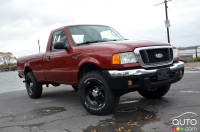kfShock absorbers play an essential role in the smooth running of your vehicle, ensuring a safe and comfortable ride. However, over time, they can wear out and require replacement. How can you recognize the signs of shock absorber wear and determine the right time to replace them? In this article, we'll look at the key indicators of shock absorber wear, and guide you through the steps you need to take to ensure your safety on the road.
When should shock absorbers be replaced?
Front and rear shock absorbers should be replaced every 80,000 kilometers or 5 years, depending on the manufacturer's recommendation. If you notice any signs of wear or significant changes in your vehicle's handling, it's best to have your shock absorbers checked by a professional.
How to recognize signs of shock absorber wear?
Here are a few telltale signs of worn shock absorbers:
- A bumpy or uncomfortable ride, with excessive vibrations felt inside the vehicle;
- An increase in braking distance, which can affect your ability to react quickly when needed;
- Excessive tilting of the vehicle when cornering or changing lanes;
- Uneven tire wear, with some sides wearing faster than others;
Abnormal noises such as squealing, banging or popping when driving on uneven roads.
When these signs of wear appear, it's important to quickly find a garage to replace your car's shock absorbers.
What causes shock absorber wear?
Shock absorbers undergo progressive wear due to a variety of causes, including :
- Normal vehicle use: shock absorbers are subject to natural wear over time as a result of daily vehicle use. As you drive over different road surfaces, the shock absorbers absorb shocks and vibrations, leading to a gradual deterioration in their performance;
- Difficult road conditions: poor road conditions, such as those with potholes, bumps, speed bumps or bumpy surfaces, put extra pressure on shock absorbers. These conditions can accelerate wear and lead to premature damage;
- Vehicle overload: when you regularly carry heavy loads or exceed the recommended load capacity of your vehicle, this can put excessive pressure on the shock absorbers. Constant overloading can lead to premature wear and reduced efficiency;
- Misuse or inadequate maintenance: aggressive driving, with hard braking, rapid acceleration and tight cornering, can accelerate shock absorber wear. In addition, inadequate maintenance, such as failure to replace wearing parts, failure to observe recommended maintenance intervals or failure to lubricate components, can lead to more rapid deterioration of the shock absorbers.
It's important to note that the factors mentioned above can interact with each other, accelerating shock absorber wear.
What are the risks of driving with worn shock absorbers?
Driving with worn shock absorbers presents several potential risks:
- Longer braking distances, which can compromise your safety on the road;
- Loss of vehicle control during sharp maneuvers or bends;
- Premature tire wear, requiring more frequent replacement;
- Deterioration of other suspension components, such as springs and ball joints.
Shock absorbers play a crucial role in your vehicle's handling and your safety on the road. If you notice any signs of wear in your shock absorbers, it's essential to have them checked and replaced if necessary. Make sure you maintain your vehicle regularly, and take the necessary steps to ensure safe driving.























